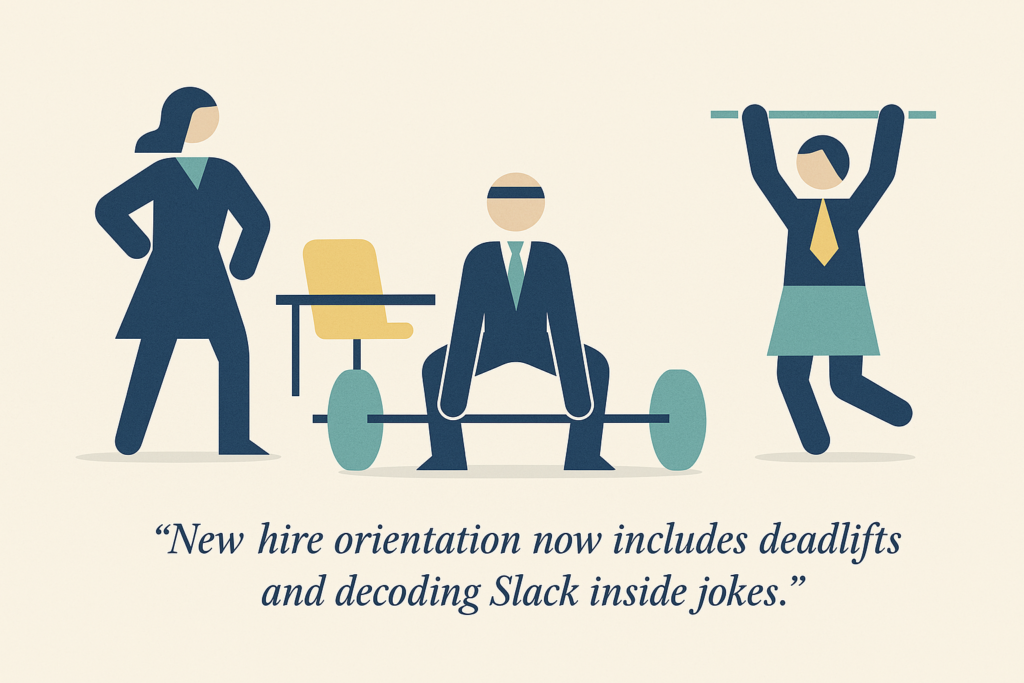Does your team feel more like Cross-Fit or Alcoholics Anonymous?
I was working with a leader named Cara who ran a high-performing, close-knit team at a SaaS company. Her people loved each other. Their Slack was chaos in the best way, custom emojis, inside jokes, birthday gifs, and more gifs. It was the kind of culture that felt magnetic… until it didn’t.
I was working with a leader named Cara who ran a high-performing, close-knit team at a SaaS company. Her people loved each other. Their Slack was chaos in the best way—custom emojis, inside jokes, birthday gifs, and more gifs. It was the kind of culture that felt magnetic… until it didn’t.
After a round of rapid hiring post-Series B funding, the cracks started to show. New hires felt like outsiders. They didn’t understand the volley of daily inside jokes being used. They weren’t invited to lunch because, “we’ve already got a thing.” The culture wasn’t cold, it just wasn’t open.
One afternoon during a company-wide strategy session, a new team member offered a suggestion to improve onboarding. One of the OGs replied kindly but curtly: “Yeah, we tried something like that two years ago so I doubt it’s going to work this time.” A few others from the old guard nodded in agreement. There was no malice. No eye rolls. Just… quiet dismissal and the meeting rolled on.
That’s when Cara saw it. Her team hadn’t built a Culture of Connection™. They’d built a culture of exclusion. The very things that made the team feel like family in the beginning were now unintentionally keeping the new people out.
She didn’t realize her community had quietly become what is called a Bounded Set Community, one where you’re either in, or you’re out.
🧱 What Is a Bounded Set Community?
Bounded Set Communities aren’t bad. They’re often born from success. But if a leader doesn’t know what kind of community they’re running, it’s only a matter of time before what once felt connected starts to feel exclusive.
In Dance Floor Theory™, we talk a lot about designing a Culture of Connection™. That means creating spaces where everyone feels like they belong and like they’re growing. But here’s the catch: not all cultures are created the same way.
There are two types of communities: Bounded Sets and Centered Sets.
Understanding which one you have is critically important to long term engagement and retention
🔲 Bounded Set Communities
A bounded set is defined by boundaries. You’re either in or out. These communities are tight, structured, and often high-trust. Think: “If you’re not one of us, you’re not in.” Here are some examples:
- 🏋️♀️ CrossFit Gyms – If you know, you know. And if you don’t, you feel like you walked into a protein-scented cult.
- There’s a distinct lingo, a dress code (knee socks, branded gear), and a level of intensity that separates “us” from “them.”
- Newcomers often feel like they have to prove themselves to get full social buy-in.
- 🏛️Greek Life (Fraternities/Sororities) – Boundaries are baked into the structure—rush week, rituals, initiation.
- You’re either a member or you’re not.
- Even alumni carry that identity long after graduation.
- This can build deep loyalty—but also exclusion for those who don’t fit the mold.
🎯 Centered Set Communities
A centered set is defined by direction. It’s not about how close you are to the center, it’s about whether you’re moving toward it. Think: “As long as you’re aligned with the mission, you belong.” Here are some examples:
- 🫂 Alcoholics Anonymous – There are no formal membership requirements.
- The only qualifier is a desire to stop drinking.
- People are welcomed based on their intention and effort, not their status, history, or success rate.
- It’s centered around healing and progress.
- 🌎Patagonia’s Environmental Mission – Patagonia openly invites customers, employees, and partners to join them in their commitment to the planet.
- You don’t have to be an outdoor purist or tree-hugger to belong—you just have to care about the Earth and want to do better.
- It’s a centered culture: moving toward impact together.
Cara’s mistake wasn’t that her culture was too close, it was that it wasn’t flexible with how close they were. When growth happened, the community resisted new energy instead of integrating it.
🧱 vs. 💧 A Metaphor to Remember
A metaphor often used to better understand these two types of communities is: Bounded sets build fences. Centered sets dig wells. You can keep people inside a space by building walls, or you can draw them toward a shared center.
🔧 Want to shift your culture from bounded to centered? Try this:
- Define your center.
What’s the core purpose or value that unites your team? What are people moving toward? Name it. Frame it. Repeat it. - Diagnose your current state.
Ask: Is belonging here based on shared values… or shared habits? Does a new person need a certain vibe, background, or unspoken rule to thrive? - Elevate bridge-builders.
Celebrate the people who reach across silos, translate the culture for new folks, and make space for others to grow into the team, not prove themselves first. - Rework your rituals.
If all your cultural moments are built on insider references, and longer term participation, shift them. Try rituals that welcome new voices or spotlight directional growth, not just tenure. - Model movement.
In centered communities, what matters is not perfection, it’s progress. Be open about how you’re still growing toward the center, too.
🧲 A Final Thought
A healthy team culture isn’t about being the tightest group in the room, it’s about building something strong enough to welcome new energy without breaking.
Your community will always have gravity. The question is: Are you building fences or digging wells?




